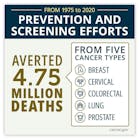The anti-cancer drug olaparib may be effective in treating biochemically recurrent prostate cancer without accompanying hormone therapy for men who have mutations in genes such as BRCA2, according to results of a phase II clinical trial of 51 patients conducted at the Johns Hopkins Kimmel Cancer Center and three other sites.
The study was done of men experiencing signs of cancer recurrence after surgical removal of the prostate, as measured by a high level of the protein prostate-specific antigen (PSA). Following treatment with olaparib, 13 participants, including all 11 who had BRCA2 mutations, had a decrease in PSA of at least 50% — a sign that their cancers were receding.
A report about the work was published August 22 in JAMA Oncology. The other participating centers were the University of Nebraska Medical Center in Omaha, the Allegheny Health Network Cancer Institute in Pittsburgh and the Thomas Jefferson University Hospital in Philadelphia.
Investigators enrolled 51 patients in the trial from May 2017 through November 2022. Each participant had biochemically recurrent prostate cancer following radical prostatectomy (surgery to remove the prostate, seminal vesicles and nearby lymph nodes). Among participants, 27 (53%) were considered biomarker positive, meaning that they had mutations in some genes that were more likely to make their cancers sensitive to olaparib. Patients had a mean age of about 64 years and median baseline PSA of 2.8 nanograms per milliliter. Most participants had a Gleason Grade Group 3 and above, meaning they had a high-grade cancer. Some 86% of participants had received radiotherapy after surgery. In patients who had positive biomarkers, alterations in BRCA2 were the most common (11 patients), followed by alterations in the ATM and CHEK2 genes (six patients each).
Participants were treated with 300 milligrams of olaparib by mouth twice daily (without hormonal suppression) until their baseline PSA level doubled, their cancer worsened as determined by imaging or other signs or symptoms, or they had unacceptable side effects/toxicity from the medication. The amount of time participants were on therapy varied — it was more than two years in some cases, says study author Cathy Handy Marshall, M.D., M.P.H.
About half (13 of 27 patients) in the biomarker-positive group had a decrease in PSA of 50% or more, including all 11 patients with BRCA2 mutations. The median duration of response was 25 months. The other two PSA responses were seen in participants with a CHEK2 mutation and an ATM mutation. No PSA responses were seen among the 24 men in the biomarker-negative group, leading the study authors to conclude that the therapy should not be considered for those patients in the future.
The median PSA progression-free survival (the length of time before PSA worsened) was 19.3 months overall and 22.1 months in the biomarker-positive subset, compared with 12.8 months in the biomarker-negative subset. The median metastasis-free survival (time from treatment to detection of metastasis) was 32.9 months overall and 41.9 months in the biomarker-positive subset, compared with 16.9 months in the biomarker-negative subset.
Also, the median time to next anti-cancer therapy was 15.4 months overall and 22.7 months in the biomarker-positive subset, compared with only 2.4 months in the biomarker-negative subset.
The most common adverse events with olaparib were fatigue, nausea and leukopenia (fewer than normal infection-fighting white blood cells).
Johns Hopkins release





